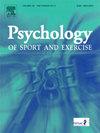Behind the mask: Attentional focus and coping strategies of elite level fencers
IF 3.1
2区 心理学
Q2 HOSPITALITY, LEISURE, SPORT & TOURISM
引用次数: 0
Abstract
This study aimed to identify attentional foci and coping strategies of elite fencers during competitive matches, explore the co-occurrences between both, and examine their impact on performance. Twenty-two epeeists (11 males and 11 females) from a national team took part in self-confrontation interviews during two simulated tournaments. Data were analysed using inductive and deductive content analyses. Moreover, a quantitative analysis of qualitative data was conducted to examine the impact of attentional foci and coping strategies on objective performance. Three categories of attentional foci were identified: (a) cues, (b) strategies and tactics and (c) extraneous attention. To depict the coping processes of elite fencers, appraisals, coping strategies and emotions were coded. Coping strategies were mainly task-oriented, and often co-occurred with strategic foci. Analysis of the co-occurrences showed that athletes could combine information from their sensations and their environment during a point. They could also use several coping strategies within or between points. Chi-square tests revealed that focusing on environmental cues, particularly spatial-temporal characteristics, was associated with more touches won and fewer touches lost. Focusing on distance/timing of actions could be relevant cues in elite fencing. Focus on internal aspects did not impair performance in the present sample. This study furthered knowledge of attentional foci and coping strategies described by elite athletes in naturalistic settings. Following the present research results, practitioners should seek to develop pre- and post-point routines that pair task-oriented coping strategies with relevant attentional focus.
面具背后精英级击剑运动员的注意力和应对策略。
本研究旨在确定精英击剑运动员在竞技比赛中的注意焦点和应对策略,探索两者之间的共存关系,并研究它们对成绩的影响。来自国家队的 22 名重剑运动员(11 男 11 女)在两次模拟比赛中参加了自我对抗访谈。我们使用归纳和演绎内容分析法对数据进行了分析。此外,还对定性数据进行了定量分析,以研究注意焦点和应对策略对客观成绩的影响。确定了三类注意焦点:(a) 提示,(b) 战略和战术,(c) 无关注意。为了描述精英击剑运动员的应对过程,对评价、应对策略和情绪进行了编码。应对策略主要以任务为导向,并经常与战略重点同时出现。对共同出现情况的分析表明,运动员可以在一个点上将来自感觉和环境的信息结合起来。他们还可以在点内或点间使用多种应对策略。卡方检验显示,关注环境线索,尤其是空间-时间特征,与赢得更多触球和失去更少触球有关。关注动作的距离/时机可能是精英击剑运动中的相关线索。在本样本中,对内部因素的关注并不会影响成绩。本研究进一步了解了精英运动员在自然环境中描述的注意力焦点和应对策略。根据本研究的结果,练习者应设法制定点前和点后的例行程序,将任务导向的应对策略与相关的注意力焦点结合起来。
本文章由计算机程序翻译,如有差异,请以英文原文为准。
求助全文
约1分钟内获得全文
求助全文
来源期刊
CiteScore
6.40
自引率
5.90%
发文量
172
审稿时长
69 days
期刊介绍:
Psychology of Sport and Exercise is an international forum for scholarly reports in the psychology of sport and exercise, broadly defined. The journal is open to the use of diverse methodological approaches. Manuscripts that will be considered for publication will present results from high quality empirical research, systematic reviews, meta-analyses, commentaries concerning already published PSE papers or topics of general interest for PSE readers, protocol papers for trials, and reports of professional practice (which will need to demonstrate academic rigour and go beyond mere description). The CONSORT guidelines consort-statement need to be followed for protocol papers for trials; authors should present a flow diagramme and attach with their cover letter the CONSORT checklist. For meta-analysis, the PRISMA prisma-statement guidelines should be followed; authors should present a flow diagramme and attach with their cover letter the PRISMA checklist. For systematic reviews it is recommended that the PRISMA guidelines are followed, although it is not compulsory. Authors interested in submitting replications of published studies need to contact the Editors-in-Chief before they start their replication. We are not interested in manuscripts that aim to test the psychometric properties of an existing scale from English to another language, unless new validation methods are used which address previously unanswered research questions.

 求助内容:
求助内容: 应助结果提醒方式:
应助结果提醒方式:


